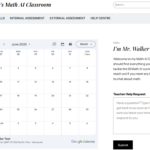When I think about datafication, I think a cold, dystopian world where every behaviour and outcome is broken down into numbers and treated by some heartless machine. It sends a shiver down my spine since it takes the heart or intuition out of how we assess and react to out students.
I think the infamous Canadian rock band rush had a similar worry but offer some optimism through their lyrics in The Spirit of the Radio: “All these machines making modern music can still be open hearted.” This, to me, is an acceptance of technology in our modern world but the burden of creation is still up to humans. While data can be collected seamlessly, we need to be careful when feeding it into AI without consideration of other factors that are less easy to quantify.
In math education, the old school way of assessing student progress and mastery is to give them a series of written tests, score them based on the ratio of correct answers to wrong, and produce a grade that is balance, mostly, on these assessments. But is this data sufficient? Can data be easily collected on other important aspects of mathematical thinking like resilience, creativity, and perspective? This sheds new light on datafication: the conclusions we draw from our data, whether from AI or old-school analysis, are only as good as the data itself. We need to ensure that the data reflects all aspects of learning rather than just the ones that are easy to quantify.
Thankfully, this has been a matter of contention in math education long before AI entered the picture. In the last several years, this problem has been addressed by taking a less quantitative approach and shifting towards the holistic. A few recent approaches in BC include:
- A move to competency-based curriculum
- A focus on rubric based marking
- A shift to other forms of assessment
In a guest session from Dr. Bonnie Steward, she mentions how datafication is supposed to eliminate human error and bias. She mentions that while turning over decision making to computational systems can save time and money, the algorithms they employ are often reductive and erroneous. I’ve experienced this first hand after purchasing a new mattress after which I was flooded with ads for new mattresses. I know google reads my emails and saw the receipt from Sleep Country. I am, in that moment, the least likely person to buy a new mattress but the algorithm couldn’t quite figure that out. This frightens me when it comes to relying on AI or quantitative data analysis to determine the needs of my students.
Connections to M.Ed project
Help-seeking is a behaviour that is complex and current literature is still developing with new aspects emerging every year. While datafication in education can be tricky, shifts to online learning environments make it much easier to track how and when students seek help from peers, teachers, and other online resources. Cho et al. (2011) found that students who sought help from online forums experience higher levels of academic achievement but only if the teacher invests some time in caring for the online space. Similarly, Yen et al. (2022) found that students who participated in online learning environments developed a stronger sense of diversified learning community and formed more competent connections with their peers.
References
Cheng, C. K., Paré, D. E., Collimore, L.-M., & Joordens, S. (2011). Assessing the effectiveness of a voluntary online discussion forum on improving students’ course performance. Computers & Education, 56(1), 253–261. https://doi.org/10.1016/j.compedu.2010.07.024
Yen, C.-J., Tu, C.-H., Ozkeskin, E. E., Harati, H., & Sujo-Montes, L. (2022). Social Network Interaction and Self-regulated Learning Skills: Community Development in Online Discussions. American Journal of Distance Education, 36(2), 103–120. https://doi.org/10.1080/08923647.2022.2041330







